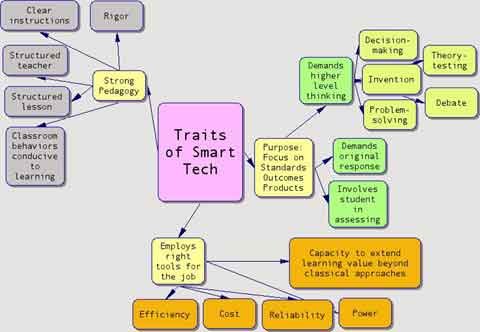|
|
| Vol 13|No 4|December|2003 | |
|
Please feel free to email this article to a friend, a principal, a parent, a colleague, a teacher librarian, a college professor, a poet, a magician, a vendor, an artist, a juggler, a student, a news reporter or anyone you think might enjoy it. Other transmissions and duplications not permitted. (See copyright statement below).
The traits identified in the cluster diagram above fall
During the past two decades, too little attention was devoted in some schools to the first two categories as there was inordinate pressure to employ new technologies without first determining if they were the right tools for the job. Note FNO article, "The Technology Presumption: Could Integrating Technology Sometimes be Wrong-Minded?" at http://fno.org/may03/wrongminded.html. If states, districts or schools presume that new technologies are always preferable, they might not consider the efficiency, cost, reliability, learning power and the capacity of such tools to extend the learning value of the curriculum unit beyond what might be achieved with more classical tools and approaches. Such presumption is both groundless and dangerous, leading to the kinds of folly portrayed in Oppenheimer's book. Sometimes it is smart to "Just say No!" rather than blindly troop down to the computer lab or take out the laptops. Sometimes paper works better. Sometimes books work better. While some schools have swallowed the technology presumption, they may have also neglected purpose and pedagogy, offering little in the way of professional development focussed on how and when to use new tools to the best effect. To make appropriate use of new technologies teachers require 40-60 hours of support for lesson design and classroom management, knowing how to structure the learning tasks while creating a classroom culture conducive to rigorous learning. Unfortunately, much of the focus thus far has been upon the learning of software and tools separate from a curricular context and a pedagogical framework.
Smart tech offers many advantages. It costs less money, it creates student learning gains, it appeals to a broader group of teachers and it helps a school avoid Powerpointlessness, Mentalsoftness, toolishness and other foolishness. |
|
Back to December Cover
Credits: The photographs were shot by Jamie McKenzie . Copyright Policy: Materials published in From Now On may be duplicated in hard copy format if unchanged in format and content for educational, nonprofit school district and university use only and may also be sent from person to person by email. This copyright statement must be included. All other uses, transmissions and duplications are prohibited unless permission is granted expressly. Showing these pages remotely through frames is not permitted. FNO is applying for formal copyright registration for articles. Unauthorized abridgements are illegal.
|
 From Now On
From Now On

